Your vision of Death Valley National Park might be like the one I had if you’ve never visited it before. I equated the name to a place so harsh nothing lives there, not a bush, tree nor creature of importance.
I was wrong. Dead wrong.
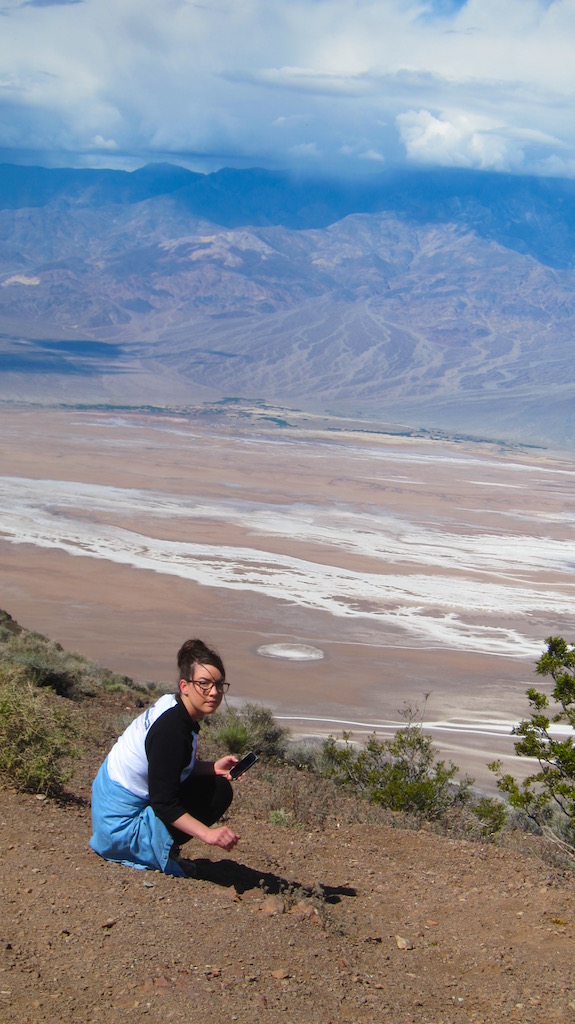
Here’s my youngest daughter admiring a flower from the Dante’s View high above Badwater Basin several thousand feet below. Photo credit: Tim Carter – W3ATB
Believe it or not, there’s a natural oasis, probably more than one, within Death Valley National Park and I happened to be staying there for two nights. It’s the The Ranch at Furnace Creek. I was there with my youngest daughter. We were on a whirlwind six-day trip through three of California’s national parks – Yosemite, Death Valley and Joshua Tree.
This vacation was special for me for a number of reasons. First and foremost I was going to be spending time with my two daughters. Second, I had never before been to Death Valley nor Joshua Tree National Parks. Both somehow escaped my attention on my many past forays out west over the past forty-five years.
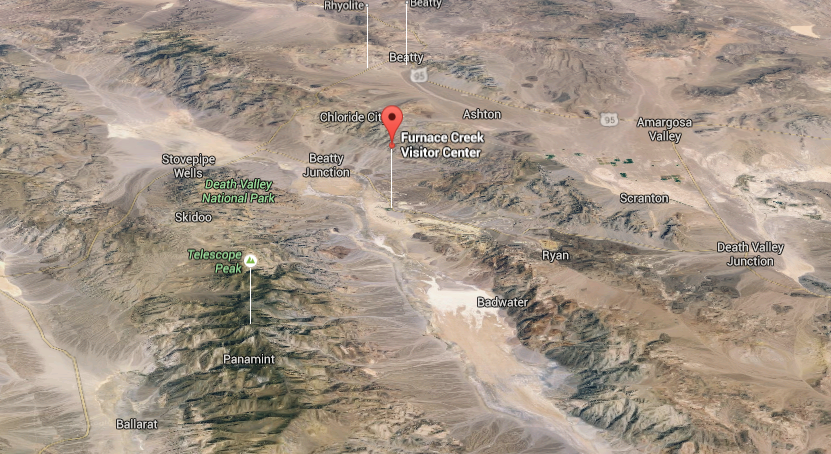
Here’s a 3D shot of Death Valley National Park and the surrounding desolate desert in southeastern California. Image credit: Google Maps (C) 2016
Within thirty minutes of arriving within the boundary of Death Valley, I knew that it was going to be jaw-dropping beautiful. We were nearing the end of a punishing 9-hour drive from Yosemite National Park. The drive would have been just a little over four hours had the Tioga Pass road at the north end of Yosemite been clear of snow.
My college degree is in geology and there’s more geologic eye candy here than any place I’ve ever seen. The variety of rocks and the range of their colors took my breath away.
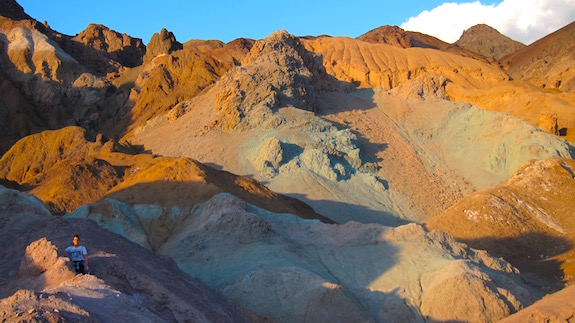
Here’s some rocks colored by volcanic activity and enhanced by the setting sun. I took this photo in the magic hour before sunset at the Artist’s Palette loop road south of Furnace Creek. Photo credit: Tim Carter – W3ATB
Before we left New Hampshire on this ten-day vacation, my daughter agreed that she’d have no problem me playing radio for several hours at each park. Just a little over 48 hours before I had successfully activated Yosemite National Park. I was anxious to try to activate the three parks we’d be visiting as part of the year-long NPOTA event.
Once we checked into our two-unit spartan room at The Ranch at Furnace Creek, Kelly and I took a walk through the compound. Just 600 feet to the west of our room was the swimming pool, golf course and a very large lawn area that was available to a motel-like structure where more guests put their heads on pillows.
I was astonished to see two massive salt-water cedar trees in a large patio area next to the lawn. Each had to be at least 40-feet tall – more than enough to string up my thin wire antenna.
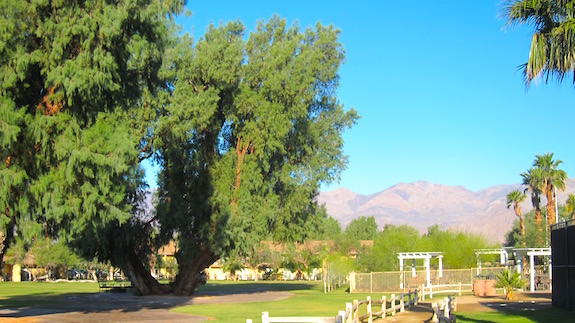
Can you believe these are thriving in the center of Death Valley? Photo credit: Tim Carter – W3ATB
The next day I set up once early in the morning before Kelly and Ieft to explore the park. I got skunked. The band simply wasn’t open.
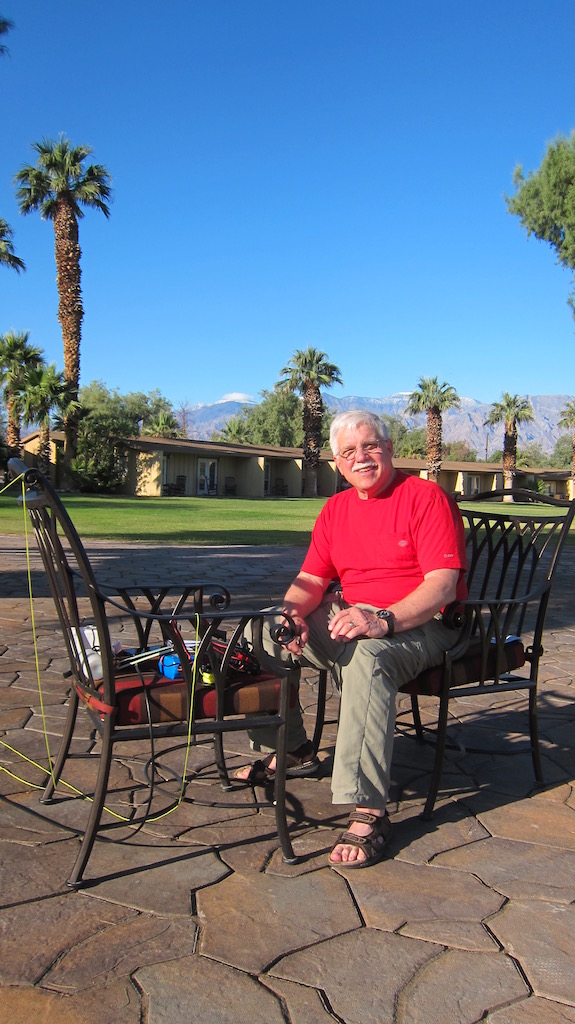
Here I am under the giant tree. I moved out of the shadow just long enough to get the photo. Photo credit: Unknown Motorcycle Tourist from San Francisco
Later in the afternoon, I came back around 3:45 PT and set up right under the one giant salt-water cedar tree. Magic was about to happen.
I went to 20 meters, texted my outdoor radio mentor Jim Cluett, W1PID that I was on 14.060 and he spotted me. Spotting is everything if you want a successful activation as part of the NPOTA. I’ve got a few other tips below.

The comfy chairs that set out around the fire rings at The Ranch made this the most comfortable activation of the three. At the others I was on the ground wondering about scorpions and snakes. Photo credit: Tim Carter – W3ATB
Once I was spotted, my Elecraft KX3 was put to work. I had it attached to a 29-foot wire that hung vertically from the massive salt-water cedar tree. The end of the wire was connected to a 9:1 unun and a 25-foot coax cable snaked across the ground to my radio. My understanding of the connections within the unun lead me to believe the coax cable acts as a counterpoise in this configuration.
Here are the stations I made contact with at Death Valley:
- K5RK 05-01 22:58
- K8NWD 05-01 23:03
- W7OM 05-01 23:03
- W1PID 05-01 23:04
- W0IS 05-01 23:08
- W6LFB 05-01 23:08
- W4OV 05-01 23:15
- N1IX 05-01 23:17
- WT8C 05-01 23:18
- KE0HWZ 05-01 23:20
- KD8DEU 05-01 23:23
Once I put the micro Pico paddles down after my last QSO, I was elated. Never before had I done that many QSOs in such a short time outdoors. It was a balmy afternoon and I realized I had reached yet another new level in my amateur radio journey.
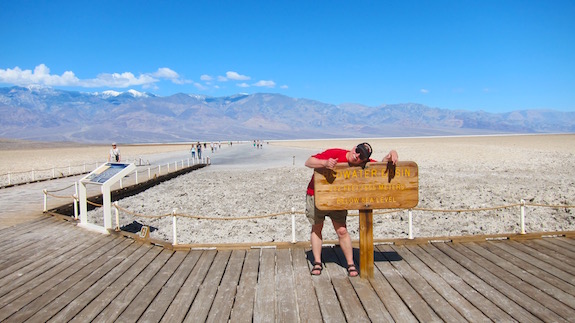
I’m at Badwater Basin – the lowest spot in the USA. Kelly and I walked about 3/4 mile out onto the salt flat behind me. That’s very close to the epicenter of the actual lowest spot in the USA. Don’t tell anyone how beautiful Death Valley is. Talk up all the scorpions and rattlesnakes. Photo credit: Kelly Carter
If you plan to do an activation at Death Valley, I highly recommend working under the giant trees I used. The area is fairly private and the tourists shouldn’t bother you. Don’t think about putting up a tripod antenna setup. Just put up a simple wire antenna as I did. It’s stealthy and it works.
You’ve got cell phone service at The Ranch so you can have a friend back in civilization spot you. Take advantage of that. Forget about activating this place between June 1 – September 30, 2016 unless you bring some eggs you want to fry on the stamped concrete next to where you’re operating.

Here’s a panoramic shot from Dante’s View. Sorry it’s so small! Photo credit: Tim Carter W3ATB

Great pictures, makes me wish I spent more time in March 2016 even tho it was drive through shooting.
Pingback: Katahdin Woods and Waters NPOTA Activation | W3ATB
Thanks for sharing. Didn’t know there was a Death Valley national park.
Pingback: Joshua Tree NPOTA Amateur Radio Activation W3ATB | W3ATB
Love the photo’s thanks for sharing your time with you and your daughter.
Really enjoyed the pictures and captions Tim. Thanks for sharing.sounds like you had a great time..thanks again.
Looks like a beautiful place Tim. Thanks for sharing the photos.
I’ve visited just about every national park west of the Mississippi. I can tell you hands down it is the most beautiful one I’ve ever seen. Perhaps the most surprising thing is Death Valley at night. There are NO lights and there’s no sound. Robbing yourself of those two sensory inputs creates a surreal experience as you lay on your back gazing up at the trillions of stars.